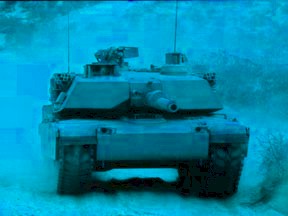Peacetime Generals have no interest in
decoys and deception. However, their value emerged after the 1999 air
attacks against Yugoslavia when the US Air Force discovered that most of its
"successful" missions had only destroyed decoys. Using decoys has become easier since modern armies use high-tech sensors, especially at
night. As a result, every armored battalion should have one section
devoted to "ghost tanks". Paratroopers should also find it
helpful to land with a few decoy tanks. This could be used to create panic
among enemy forces when they receive numerous reports of heavy tanks in their
rear area. 
A single truck can carry two dozen inflatable tanks and armored vehicles to fool the enemy. Modern technology allows the following improvements:
-Develop several variations: some with the main gun off center, a tank commander in the hatch, an armored personnel carrier, and self-propelled artillery.
-Use inflatable frames made of harder rubber like those used in large inflatable tents. This requires less air than inflating the entire decoy and problem of punctures is far less.
-Hook up groups of tanks to a small generator which provides hot air and electricity
to heat up key areas of the decoy with wiring like that used in an electric
blankets. This will guarantee it looks like a tank to anyone with infrared
viewers. The hot air pump will also ensure the tank doesn't deflate from
minor punctures. Imagine the panic among attacking enemy tankers as they
shoot several rounds at a ghost tank and "miss" each time as the
projectile passes through.
-Use a couple of "moving" decoy versions mounted on a tiny vehicle (like a riding lawnmower) which can move the ghost tanks along a few miles an hour. This is similar to the trucks built as decoy tanks used in Africa during World War II. (left) Remote controlled ghost tanks could be used to lead the charge in tank attacks. Not only would they attract enemy weapons away from regular tanks, they will frighten the enemy as their powerful projectiles seem to have no affect on these advancing tanks. A ghost tank can also lead the way down roads where the threat of rearguard ambushes are expected.
During wartime, decoys will be placed forward of regular tanks in defense positions so an attacking enemy will waste his rounds "engaging" them. Such decoys are ideal for use as targets at training ranges during peacetime. They will also help tankers understand how easily they can be fooled.
If enemy aircraft or helicopters are a threat, ghost tanks can be placed in open areas away from regular tanks to invite attack. They may also be placed as bait by anti-aircraft crews setting a trap. Even when "destroyed", ghost tanks can be quickly patched and put "back in action". Army officers must understand the lethality and range of today's weapons makes it essential to include deception in every battle plan. One truck with modern inflatable ghost tanks can provide two companies of tanks to intimidate and confuse an enemy.
Carlton Meyer editorG2mil@Gmail.com
©2003 www.G2mil.com
Letters
Looks like the Chinese are way ahead with this idea. http://www.shape.com.cn/html_en/dummy_military.htm
Phil West